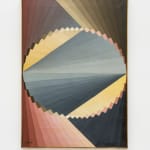Habuba Farah Brasil, 1931-2025
Further images
PT
A partir dos contatos de Habuba Farah com artistas como Samson Flexor (1907-1971), a produção de pinturas de 1952 a 1961 da artista aponta o desenvolvimento da sua “abstração geométrica lírica”, denominação dada pelo crítico e físico Mário Schenberg. Os trabalhos desse período afirmam seu fascínio pela cor, pelas linhas retas e pelos experimentos que essa combinação rica em possibilidades poderia lhe proporcionar.
Do fim da década de 1950 até a década de 1970, a produção da artista se estrutura a partir das chamadas paraboloides. Habuba toma como base as séries de estudos que precedem as pinturas, nos quais ela se dedica a distorcer planos e criar volumes ordenados por linhas. Nessas pinturas, a cor ressalta o movimento seja por interrupção seja por continuidade: movimentos rápidos e acidentados nas composições mais contrastantes; lentos e fluidos naquelas que usam subtonalidades. As diagonais, presentes na produção da artista desde o início, são agora acompanhadas por círculos, semicírculos, espirais e ondulações.
Ainda nos anos 1970, Habuba explorou formatos horizontais em trabalhos que apresentam aspectos cromáticos opostos, alternando os matizes e os neutros como se seguisse em positivo e negativo. Assim, seu trabalho lúdico com a geometria, como ela mesma diz, vai se tornando mais complexo, incorporando mais elementos (formas e cores), e ganhando movimentos vertiginosos. O próprio formato da tela passa a compartilhar dessa lógica, como nos casos em que pinturas quadradas podem ser apresentadas também como losangos.
EN
From Habuba Farah's encounters with artists such as Samson Flexor (1907-1971), her paintings from 1952 to 1961 point to the development of her "lyrical geometric abstraction", as the critic and physicist Mário Schenberg called it. The works from this period affirm her fascination with color, straight lines, and the experiments that this rich combination of possibilities could provide her.
From the late 1950s to the 1970s, the artist's production was structured around the so-called paraboloids. Habuba's work is based on a series of studies that precede the paintings, in which she distorts planes and creates volumes ordered by lines. In these paintings, color emphasizes movement, either through interruption or continuity: fast, bumpy movements in the more contrasting compositions; and slow, fluid movements in those that use sub tonalities. Diagonals, present in the artist's production from the beginning, are now accompanied by circles, semicircles, spirals, and ripples.
Still in the 1970s, Habuba explored horizontal formats in works that present opposing chromatic aspects, alternating hues, and neutrals as if in positive and negative ways. In this sense, her playful work with geometry, as she says, became more complex, incorporating more elements (shapes and colors) and gaining vertiginous movements. Also, the shape of the canvas shares this logic, as in the cases where square paintings can also be presented as rhombuses.
Exhibitions
Habuba Farah. Gomide&Co: São Paulo, 28 de novembro de 2023 a 09 de fevereiro de 2024 [November 28th, 2023, to February 09th, 2024]5º Salão Oficial de Arte Contemporânea de Piracicaba. Salão Oficial de Arte Contemporânea de Piracicaba: Piracicaba, 1972
Literature
Habuba Farah. São Paulo: Gomide&Co e Mapa, 2023 - p. 2-3 e 123Habuba Farah: Obras iniciais [Early works]. São Paulo: Gomide&Co e Galeria MaPa, 2021 - p. 25
Habuba Farah. São Paulo: Galeria MaPa, 2020 - p. 9
Join our mailing list
*required fields
We will process the personal data you have supplied in accordance with our privacy policy (available on request). You can unsubscribe or change your preferences at any time by clicking the link in our emails.
![Habuba Farah, Sem título [Untitled], 1964](https://artlogic-res.cloudinary.com/w_1800,h_1320,c_limit,f_auto,fl_lossy,q_auto/artlogicstorage/bergaminandgomide/images/view/2b6355e9c020385d1f3a1a3572ec2db1j/gomide-co-habuba-farah-sem-t-tulo-untitled-1964.jpg)
![Habuba Farah, Sem título [Untitled], 1964](https://artlogic-res.cloudinary.com/w_1800,h_1320,c_limit,f_auto,fl_lossy,q_auto/artlogicstorage/bergaminandgomide/images/view/1e78952dd746b51565b7e9ea350c641cj/gomide-co-habuba-farah-sem-t-tulo-untitled-1964.jpg)
![Habuba Farah, Sem título [Untitled], 1964](https://artlogic-res.cloudinary.com/w_1800,h_1320,c_limit,f_auto,fl_lossy,q_auto/artlogicstorage/bergaminandgomide/images/view/4b6eceb52005d273c8a78b65c639d0b2j/gomide-co-habuba-farah-sem-t-tulo-untitled-1964.jpg)
![Habuba Farah, Sem título [Untitled], 1964](https://artlogic-res.cloudinary.com/w_1800,h_1320,c_limit,f_auto,fl_lossy,q_auto/artlogicstorage/bergaminandgomide/images/view/0c099216a1f788aec5d4711f5a32331dj/gomide-co-habuba-farah-sem-t-tulo-untitled-1964.jpg)



